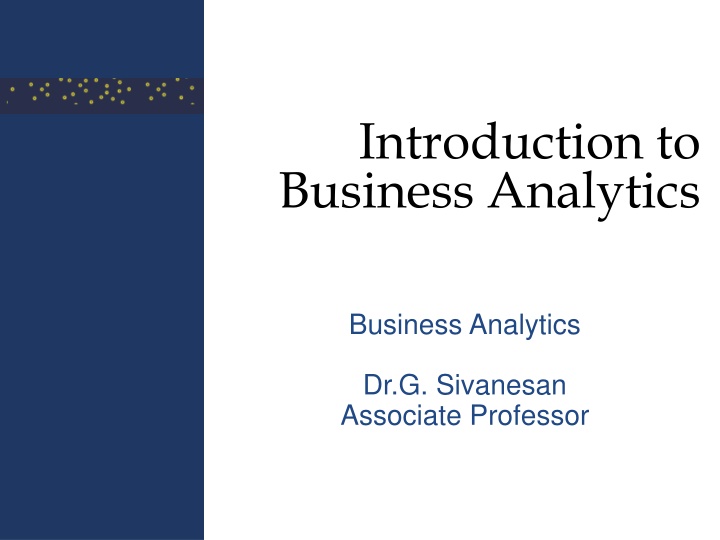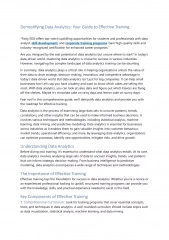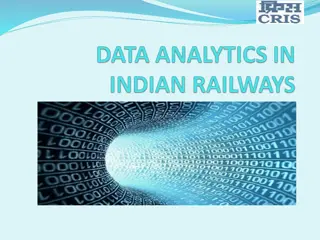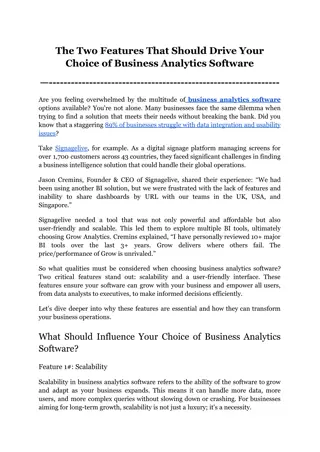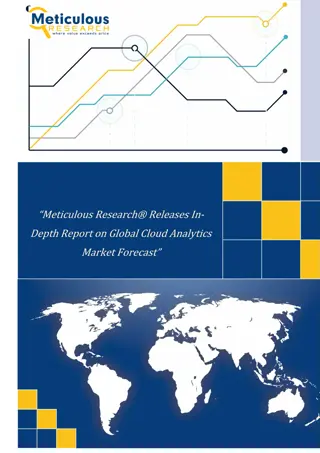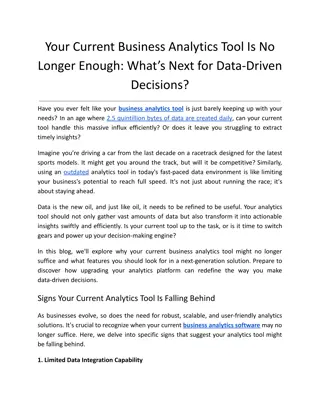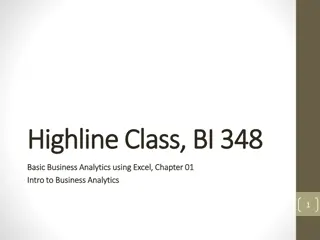Unleashing the Power of Business Analytics for Enhanced Decision-Making
Businesses are leveraging data and analytics capabilities to transform decision-making processes. This shift has been driven by the availability of vast amounts of data, improved computational power, and sophisticated algorithms. The incorporation of business analytics in various sectors like marketing, finance, and human resource management has revolutionized how organizations tackle key challenges, enhance efficiency, and identify new opportunities. Predictive analytics utilizes historical data to make future predictions, while prescriptive analytics offers actionable insights for optimal decision-making. By harnessing the potential of business analytics, companies can boost performance, improve customer experiences, and drive growth.
Download Presentation

Please find below an Image/Link to download the presentation.
The content on the website is provided AS IS for your information and personal use only. It may not be sold, licensed, or shared on other websites without obtaining consent from the author.If you encounter any issues during the download, it is possible that the publisher has removed the file from their server.
You are allowed to download the files provided on this website for personal or commercial use, subject to the condition that they are used lawfully. All files are the property of their respective owners.
The content on the website is provided AS IS for your information and personal use only. It may not be sold, licensed, or shared on other websites without obtaining consent from the author.
E N D
Presentation Transcript
Introduction to Business Analytics Business Analytics Dr.G. Sivanesan Associate Professor 8/4/2024
Overview of Business Analytics Data and analytics capabilities have made a leap forward. Growing availability of vast amounts of data Improved computational power Development of sophisticated algorithms Colleges/universities have curriculum emphasizing business analytics Data and analytics capabilities have changed the way businesses make decisions. Companies need data-savvy professionals Turn data into insights and action Business analytics (data analytics) involves extracting information and knowledge from data. Improve the bottom line Enhance the customer experience Develop better marketing strategies Deepen customer engagement Enhance efficiency and reduce expenses Identify emerging markets Mitigate risk and fraud
Overview of Business Analytics Business analytics is widely applied. Marketing Human resource management Economics Finance Health, sports, and politics Business analytics combines qualitative reasoning with quantitative tools. Identify key business problems Translate data analysis into decisions Improve business performance
Overview of Business Analytics Predictive Analytics: what could happen in the future? Use historical data to make predictions Analytical models help identify associations Associations used to estimate the likelihood of a favorable outcome Commonly considered advanced predictions Build models that help an organization understand what might happen in the future Use statistics and data mining Examples Identifying customers who are most likely to respond to specific marketing campaigns Transactions that are likely to be fraudulent
Overview of Business Analytics Prescriptive Analytics: what should we do? Optimization and simulation algorithms to provide advice Explore several possible actions Suggest course of action Commonly considered advanced predictions Build models that help an organization understand what might happen in the future Use statistics and data mining Examples Scheduling employees works hours Select a mix of products to manufacture Choose an investment portfolio
Types of Data Businesses generate and gather more and more data at an increasing pace: Big Data. A massive volume of structured and unstructured data Extremely difficult to manage, process, and analyze using traditional data processing tools Present great opportunities to gain knowledge and game-changing intelligence
Types of Data There are three characteristics of big data. Volume: immense amount of data compiled for a single or multiple sources Velocity: generated at a rapid speed, management is a critical issue Variety: all types, forms, granularity, structure or unstructured Additional characteristics Veracity: credibility and quality of the data, reliability Values: methodological plan for formulating questions, curating the right data, and unlocking hidden potential Having a plethora of data does not guarantee that useful insights or measurable improvements will be generated.
Variables and Scales of Measurement Analysis techniques depend on the type of data. There are four major scales: nominal, ordinal, interval, ratio Nominal Categorical Least sophisticated Values differ by label or name Example: marital status Ordinal Categorical Reflect labels or name, but can be ranked Cannot interpret the difference between the ranked values Example: reviews from 1 star (poor) to 5 stars (outstanding) Interval Numerical Categorize and rank, differences are meaningful Zero value is arbitrary and does not reflect absence of characteristic Ratios are not meaningful Example: temperature Ratio (numerical) Numerical Most sophisticated A true zero point, reflects absence of characteristic Ratios are meaningful Example: profits
Variables and Scales of Measurement Example: The owner of a ski resort gathers data on tweens. Music: nominal Food quality: ordinal Closing time: interval Own money spent: ratio
